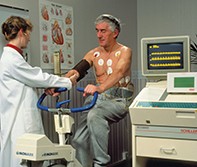Peer Reviewed
Feature Article Cardiovascular medicine
Stable angina pectoris: evaluation and treatment
Abstract
The investigation and management of a patient presenting with chest pain are guided by the probability of the patient having significant coronary artery disease.
Key Points
- The probability of significant coronary artery disease (CAD) in a patient presenting with chest pain guides further investigation and management, and can be assessed with a simple diagnostic algorithm.
- The differential diagnoses of stable angina pectoris include musculoskeletal chest pain, gastro-oesophageal pain, peptic ulceration, biliary disorders and anxiety/hyperventilation.
- For patients with an intermediate pretest probability of CAD and mild or equivocal symptoms, assessment with a provocative stress study is useful for both diagnosis and risk stratification.
- Beta blockers are first line therapy for symptom control as they most effectively reduce exercise and stress induced tachycardia. Sublingual glyceryl trinitrate relieves anginal symptoms. Antiplatelet agents, ACE inhibitors and statins improve cardiovascular outcomes.
- Percutaneous coronary intervention or coronary artery bypass grafting is indicated particularly in patients with troublesome or refractory symptoms or where significant ischaemia is identified.
- Patients should be counselled regarding long term control of risk factors.
Purchase the PDF version of this article
Already a subscriber? Login here.

